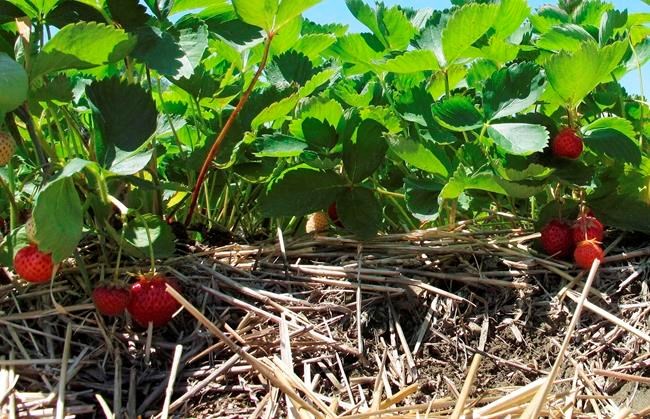A bug encroaching on Quebec’s strawberry fields could help forecast climate change's impact on agriculture, a new study suggests, the latest to consider what the authors called the "colossal task" of sustainable farming on a warming planet.
Researchers out of Laval University say migratory leafhoppers – small cicada-like insects that benefit from temperature increases – appear to be arriving earlier in the season and dominating fields around Quebec City. They suggest the leafhopper's migratory patterns, expanded territory and potential to carry plant diseases help make the insect an ideal model species for scientists to study how climate change is affecting agriculture.
"What we thought was a local study could have a significant impact on the way we trace the implications of climate change on agriculture and how we will manage the imminent biological invasions already happening in places such as Canada," read the study published Friday in the journal Cell Reports Sustainability.
The research adds to the science about how climate-driven pest invasions could threaten food security and exacerbate agriculture's environmental impact due to increased pesticide use, the study said.
Leafhoppers are well-known carriers of bacteria viruses, the study said, and more research is needed to figure out if they are contributing to a reported increase in diseased strawberry plants around Quebec.
There were 16 cases of strawberry green petal disease reported in Quebec between 2012 and 2022, with a clear increase in the last three years, the study said.
"If achieving sustainable agriculture is a challenge, achieving sustainable agriculture in a changing climate is a colossal task that requires all the tools at our disposal," the study read.
Leafhoppers are a big family of slender sap-sucking insects that total more than 20,000 described species – more than reptiles and birds combined. The winged adults are not particularly good at flying but, as their name suggests, they are great jumpers whose springy steps have been said to hold hints for making better robotics.
But their increased presence has raised concern on some Quebec farms, which supplied more than half of Canada's strawberry production in 2021.
Valérie Bernier-English, who works as a research and development manager at a commercial berry farm and nursery on l'Île d'Orléans, said she first noticed leafhoppers in the fields about eight years ago and their numbers have grown.
She said although the insect has caused few problems at the farm, it makes work more complicated and pushes the farm to use more insecticides.
"We have never experienced a big problem, like the complete destruction of the crop," she said. "But their presence is significant, and we worry just because we don't know if they make more damage, like collateral damage, by carrying virus."
Over two seasons in 2021 and 2022, researchers collected thousands of leafhoppers in strawberry fields around Quebec City. Among them, researchers spotted 10 species never before reported in Quebec, and two of those were reported for the first time in Canada.
Four of those species were also spotted the furthest east ever reported in the country.
Lead author Nicolas Plante, whose master's research supported the study, said some of those species are invasive and can be vectors for new bacterial diseases that affect plants.
"This is something that climate change can also bring in the future because with the increase in temperatures, new area becomes more viable for these type of leafhopper," said Plante.
Despite the new leafhoppers reported in the area, the study said the species diversity was actually lower than in the past. Two migratory species, aster and potato leafhoppers, dominated.
Those leafhoppers, which ride wind currents from the southern United States to Canada in the spring, were arriving up to 10 days earlier than predicted just a few years ago, said co-author Edel Pérez-López, a plant pathologist and associate professor at Laval University.
He said his group took samples from some of the most abundant leafhoppers and found bacteria that could be harmful to strawberry plants. That bacteria has not turned up in plants, he said, "but the fact that they are in the insects are a big worry."
Making clear links between observed trends and climate change can be a challenge for scientists. Insect migration or disease trends could be influenced by a number of factors that may not be directly linked to climate change.
But Pérez-López said they felt confident drawing that link in this paper, in part because the group has also used models to try to predict how leafhopper migration could change as the planet warms.
"What we found is not good," he said of his group's not-yet-published modelling study. "Many of the places that are going to be hot spots are also in the Prairies. And we know that some of these leafhoppers are vectors of disease in canola and other big crops that are important for the Canadian economy."
His group's research team secured three more years of funding from the Quebec government. But they also have a proposal before a federal agency to expand the research to include canola and blueberry crops.
"We are working with researchers from all (across) Canada to see if something similar is happening at a Pan-Canadian level, and also to try to find solutions that not only work for Quebec growers, but also for all Canadian growers," he said.
"We see that this is going to be a problem, a huge problem, in the coming years."
Preliminary data published in Friday's study also looked at four commonly used insecticides and found no significant difference between leafhopper abundance before and after application.
Pérez-López said a focus of further study will be to look at ways to make insecticide use more efficient and reduce the total amount of chemicals used.
This report by The Canadian Press was first published Feb. 23, 2024.
Jordan Omstead, The Canadian Press



